Entries from April 1, 2019 - April 30, 2019
Euroland money trends turning positive
A slowdown in Euroland narrow money in late 2017 / early 2018 suggested that the economy would lose momentum over the course of last year. Coincident economic indicators such as the purchasing managers’ surveys were riding high in early 2018 and the ECB and consensus ignored the monetary warning signal.
Could the reverse scenario be about to play out? The manufacturing PMI fell to a six-year low in March, the ECB has slashed its forecasts and commentators are warning of heightened recession risk. Previous posts, however, noted that money trends had improved since late 2018 and March data released today provide further evidence of a pick-up, as discussed below.
One difference from late 2017 / early 2018 is that Euroland monetary developments have “decoupled” from trends in the US and China. Then, Euroland weakness was part of a synchronised global monetary slowdown, suggesting that economic growth would be held back by net exports as well as domestic demand. Now, global money trends have yet to echo the Euroland pick-up, implying that the trade drag may persist.
There are, moreover, downside economic risks from US trade policy and Brexit. These risks are probably dampening business “animal spirits”, in turn implying that any economic pick-up could be muted and / or delayed.
Stronger monetary trends, nevertheless, are judged here to warrant shifting to a positive view of Euroland economic prospects relative to a gloomy consensus. Recession fears, in particular, appear groundless – barring trade / Brexit shocks.
Annual growth of narrow money, as measured by non-financial M1, stabilised around year-end and rose to 7.9% in March, a 14-month high, suggesting that annual nominal GDP expansion will recover later in 2019 – see first chart.

Growth of the broad non-financial M3 measure also increased further, to 5.1%. The headline M1 / M3 money measures are lagging the non-financial aggregates tracked here but have also shown a clear acceleration recently – second chart.

Six-month growth of real non-financial M1 (i.e. deflated by consumer prices) continued its recovery from a low reached in July 2018 and is high by current global standards – third chart*.

Overnight deposits within non-financial M1 break down into household and corporate components; both are expanding solidly – fourth chart.

Deposit growth remains strongest in France and Spain but there was a notable pick-up in Germany last month, while Italy continues to lag – fifth chart.

*Latest data = March except for UK (February).
Six of the best: recent economic news highlights
G7 headline consumer price inflation was pushed up by rising energy costs in March but the core rate subsided to a 14-month low – see first chart. The core decline contradicts the consensus forecast last year, based on Phillips’ curve “theory”, that rising capacity use and labour market tightening would boost underlying inflationary pressures.
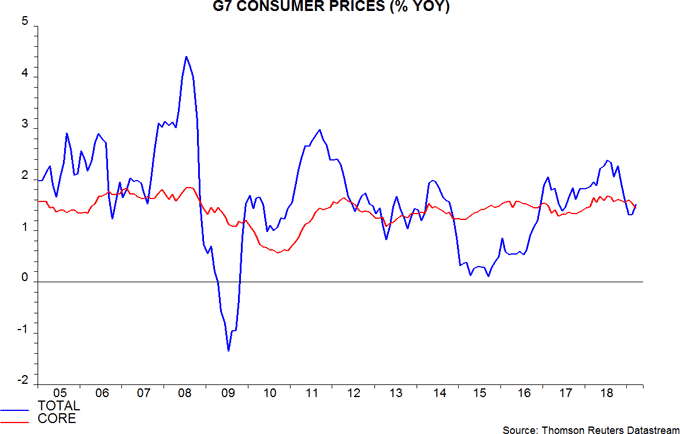
The core slowdown, however, is consistent with the “monetarist” rule of thumb that inflation follows monetary trends with a long and variable lag, averaging about two years. Global annual narrow money growth peaked in late 2016 and subsequent weakness is now being reflected in falling nominal GDP expansion, a trend likely to continue into 2020 – second chart.

April “flash” PMI results for the US and Euroland showed a stabilisation of manufacturing indices after recent falls. As expected, however, economic weakness is now spreading to services – third chart. This broadening-out increases conviction that labour market resilience will be next to crumble.

Global growth hopes were boosted by sizeable rises in official and Markit Chinese manufacturing PMIs in March but the results were probably affected by forward purchasing to maximise tax relief ahead of a VAT cut from 1 April. Earnings forecast revisions by equity analysts have remained soft – fourth chart. Will April PMI results next week disappoint?

Resurgent investor confidence also reflects a belief that monetary policy-makers “have your back” following the Fed’s U-turn on interest rate guidance and dovish shifts by other major central banks. Fed policy, however, is still tightening because of the delayed ending of QT, with the monetary base projected to contract by a further 6% by end-September – fifth chart.
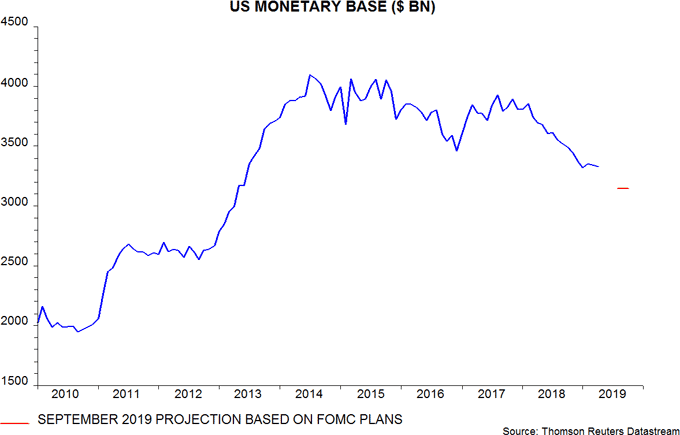
Markets have ignored a string of negative US activity reports – the Citi economic surprise index is at a two-year low – but narrow money trends suggest further weakness ahead. Six-month money growth slumped in March, with no recovery in early April – sixth chart.

China activity data: hold the champagne
Discount the headlines – the Chinese economy remained soft in early 2019.
Official real GDP numbers are implausibly smooth. Nominal GDP trends are a better guide to economic swings. Nominal GDP changes reflect developments in prices as well as output but a crude adjustment can be made by deflating the numbers by the consumer price index.
The first chart shows two-quarter changes in the above three series, seasonally adjusted*. All three slowed further in the first quarter.

The declines are not an artefact of using two-quarter changes. Quarterly growth of the official real GDP series also fell last quarter, to 1.4% from 1.5% in the fourth quarter.
The further slowdown in nominal GDP is consistent with weak money trends in mid-2018: six-month growth of true M1 reached a low in August last year – second chart.

The subsequent stabilisation and recent modest recovery in narrow money growth suggest that nominal GDP expansion is at or near a low and will revive slightly over the remainder of 2019. A 2016-style acceleration, however, is not in prospect, based on current monetary trends.
What about super-strong industrial output numbers for March, showing a surge in year-on-year growth to 8.5% from 5.3% in January-February? Doesn’t this imply an end-quarter economic pick-up that will feed through into significantly better second-quarter GDP results?
Industrial output strength was not reflected in other monthly series. Retail sales growth, adjusted for inflation, fell slightly compared with January-February – third chart.

Growth of fixed asset investment – a value series – edged higher but remains range-bound. As expected, recent profits weakness has fed through to a slowdown in private investment, offsetting a pick-up in government spending – fourth chart.

The March spike in industrial output growth is partly attributable to the timing of the New Year holidays in 2018 and 2019, which resulted in front-end loading of first-quarter production last year and back-end loading this year. This artificially depressed year-on-year growth in January / February, with a compensating boost to March.
In addition, the VAT cut from April created an incentive for companies to bring forward purchases of inputs to benefit from relief at the old rate. Supplier firms boosted output to accommodate this temporary demand. This probably also partly explains the larger-than-expected rises in official and Markit / Caixin manufacturing PMIs last month.
Both reasons suggest a normalisation of output growth in April to around the first-quarter average of 6.5%.
*Real GDP seasonally adjusted by source; own adjustment for nominal GDP.
China money update: additional data less positive
Commentary on Friday suggested that Chinese money trends had improved but were still far from signalling economic strength. Additional March data released today reinforce a cautious interpretation.
The key measure monitored here is true M1, which adds household demand deposits to the official M1 aggregate to align with the internationally-recognised M1 definition. The demand deposit information is usually released several days after the headline money data. Friday’s commentary assumed that household demand deposits rose by 2.0% month-on-month in March. This was a reasonable assumption because such deposits normally move in the same direction as total household deposits but by a larger percentage – total deposits increased by 1.1% last month.
The additional details were released today – earlier than usual – and show that household demand deposits fell by 1.0% in March. Annual true M1 growth, therefore, was 5.2% rather than the estimated 6.3%. Six-month growth, seasonally adjusted but not annualised, was 2.7% versus 3.8%. This still represents an improvement from February but the recent recovery is unimpressive – see first chart.
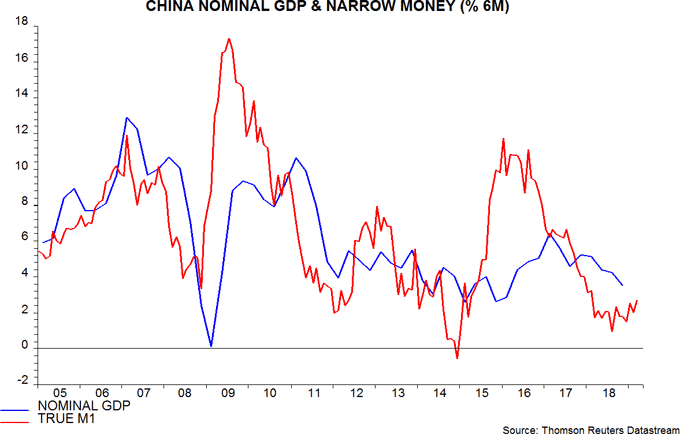
This also has implications for global six-month real narrow money growth, which is now estimated at 1.4% in March rather than 1.6%, implying that last month’s decline reversed half of the recovery between October and February – second chart.
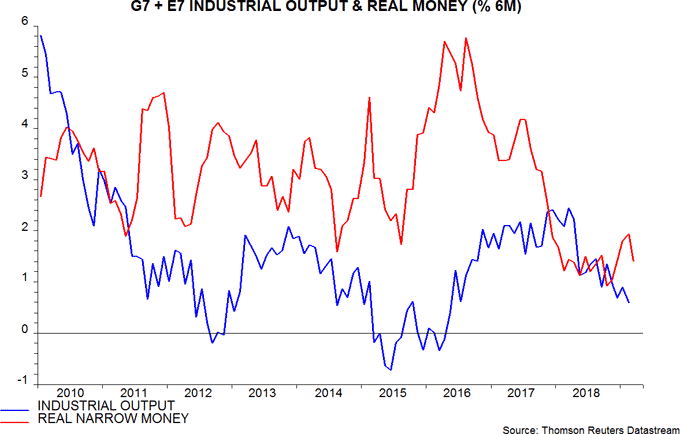
Global money update: US weakness offsets Chinese improvement
China and the US released March money data overnight. The Chinese numbers were positive, though not strong, while US data confirmed a sharp slowdown in narrow money indicated by earlier weekly data. Also factoring in a rise in headline inflation, the net result is that global six-month real narrow money growth is likely to have reversed lower last month, following a small recovery over October-February. This suggests that global economic prospects are deteriorating again, with US weakness likely to offset and delay a tentative Chinese recovery.
The first chart shows six-month growth rates of Chinese narrow / broad money measures and the total social financing (TSF) credit aggregate. Previous commentary expressed disappointment at the lack of response of narrow money growth to policy easing but there was a clear pick-up in March. This confirms an earlier rise in broad money growth, which levelled off in February / March. TSF expansion, meanwhile, ticked higher last month but six-month growth continues to be depressed by soft flow numbers in late 2018.

Growth of narrow money and TSF remains weak by historical standards, with the rises from the recent lows much smaller than before significant economic accelerations in 2009 and 2016. The increases are also less impressive than in 2012, when nominal GDP growth subsequently stabilised but did not strengthen.
The second chart compares six-month growth rates of real narrow money across major economies and includes March data for Japan as well as the US and China. The rise in Chinese real money growth in March was smaller in magnitude than a US move from expansion back into contraction. Of the 2.6 percentage point (pp) US fall, 2.2 pp reflected nominal money weakness and 0.4 pp an energy-driven rebound in inflation. The level of US real narrow money is lower now than in late 2017.

The global real money measure in the third chart also incorporates March data for India (strong, partly reflecting an election effect) and Brazil (weak). Six-month growth is estimated to have fallen back from 2.0% to 1.6% – below the level in all but one month over 2009-17.

As previously discussed, the inflation drag on global real money growth is likely to increase into mid-year, reflecting recent commodity price gains – fourth chart.

A "monetarist" perspective on current equity markets
The forecasting approach employed here – relying on monetary and cycle analysis – suggested that global economic momentum would continue to weaken through the first half of 2019. Incoming news has supported the scenario but equity markets have rallied strongly, partly reflecting an inflation-driven improvement in the monetary backdrop. We doubt that this will be sustained and expect further weak data to undermine investor hopes of an early economic recovery.
The monetary aspect of the forecasting process relies on the empirical rule that turning points in real (i.e. inflation-adjusted) money momentum lead turning points in economic momentum, on average by about nine months. The narrow M1 aggregate – comprising currency in circulation and demand or overnight deposits – has provided more reliable signals historically than broader money measures. Global six-month real narrow money growth reached a 10-year low in October 2018, recovering through February 2019. The October low suggested that a low in economic momentum was unlikely to be reached until around July 2019. Consistent with the forecast, six-month industrial output expansion is estimated to have fallen further through February 2019 – see first chart.

Why, then, have equity markets rallied? The economic slowdown has fed through to earnings forecasts – the IBES consensus estimate for MSCI World EPS in 2019 was cut by 5.1% between December and March – but the impact on equity prices has been more than offset by a fall in the discount rate as risk-free real yields have tumbled. We attribute this partly to the Fed’s policy U-turn and partly to the recovery in global real money momentum between October and February, which resulted in our two “excess” money indicators turning positive*. Excess money is associated with excess demand for financial assets at their prevailing prices, and consequent upward pressure on those prices (and downward pressure on yields).
In terms of our framework, a forecast that equity markets will rise further requires belief that 1) the recovery in monetary trends since October presages a significant revival in economic momentum later in 2019, 2) investors will “look through” intervening further weakness and 3) excess money will continue to support asset prices. We are sceptical on all three counts.
On 1), the rise in global six-month real money growth since October has been modest, with the February level – 2.0% – lower than in all but three months between October 2008 and November 2017. A further increase to 3% or more may be needed to signal a return to trend economic expansion.
The recovery, moreover, has been driven by a slowdown in six-month consumer price inflation, as weakness in oil and other commodity prices in late 2018 fed through to headline indices. Nominal money growth has remained within its 2018 range – second chart. With commodity prices recovering in early 2019, the inflation decline is likely to reverse into mid-year. Real money growth, therefore, may fall back unless nominal monetary trends strengthen.

On 2), equity markets are less forward-looking than many investors perceive. We examined the behaviour of global equity prices around 13 prior lows in six-month industrial output momentum since 2000. Equities fell after the trough in four cases, while lows coincided on one occasion. In the remaining eight instances, equities bottomed a maximum of six months before the low in economic momentum, with an average lead of 2.75 months.
Equity bulls believe that markets bottomed in December 2018. If our forecast of a low in economic momentum in July 2019 proves correct, this would imply a seven-month lead – outside the historical range.
On 3), we anticipate that one of our two excess money measures will turn negative because of the expected inflation rebound into mid-year.
The third chart shows monetary developments in individual major economies. US real narrow money contracted in the year to November 2018, suggesting weak economic prospects for the first three quarters of 2019. Money trends recovered modestly in early 2019 but weekly data for March – not included in the chart – indicate a sharp set-back. Accordingly, we do not expect the US economy to return to strong growth before 2020.

Investors are hoping that a policy-driven pick-up in Chinese activity will lift global economic expansion later in 2019. Chinese real narrow money growth has revived since late 2018 but the increase to date has been much smaller than those preceding economic recoveries in 2009, 2013 and 2016. We expect activity news to disappoint near term and await a more convincing monetary acceleration to become positive on prospects for late 2019 / early 2020.
Euroland economic news was particularly disappointing in late 2018 / early 2019, contributing to equity investors moving significantly underweight the region, according to surveys. Real narrow money growth, however, has rebounded since mid-2018 and is higher than in other major economies, arguing against recession concerns – real money contracted before the 2008-09 and 2011-12 downturns. GDP expansion may stabilise in the first half of 2019 and recover later in the year – barring external shocks.
The cycles element of the forecasting approach provides longer-term context and acts as a cross-check of the monetary analysis. The two cycles of interest at present are the stockbuilding or inventory cycle, which has averaged 3 ½ years in length in recent decades (measured from trough to trough), and the longer-term business investment cycle, averaging 8 ½ years.
The stockbuilding cycle, on our analysis, last bottomed in the first quarter of 2016, implying that another trough could occur around the third quarter of 2019, assuming that the current cycle is of average length. The contribution of stockbuilding to G7 annual GDP growth rose to a 15-quarter high in the fourth quarter of 2018, consistent with the cycle being at or near a peak, while more recent business survey evidence signals a downswing – fourth chart.
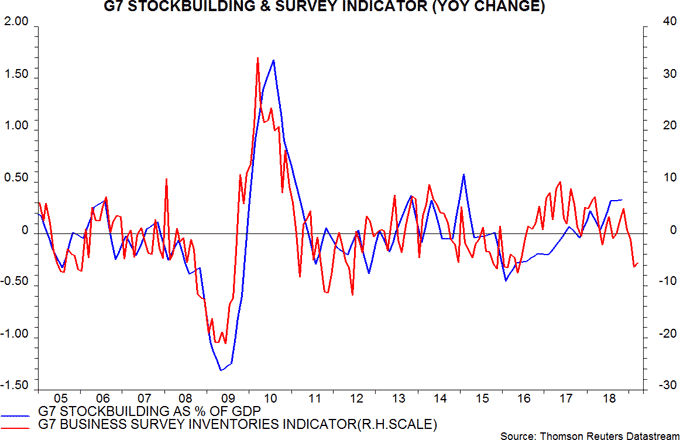
We judge that the business investment cycle last bottomed in the second quarter of 2009, implying that the current cycle is already longer than average. Assuming that it does not stretch beyond 10 ½ years – the maximum length in recent decades – another trough could occur by end-2019. This cycle also appears to have peaked in late 2018, judging from recent falls in output / orders of capital goods producers, with declining profits likely to intensify weakness later in 2019.
The cycles analysis, therefore, supports the negative signal for near-term economic prospects from monetary trends, while suggesting a growth bounce-back in 2020, when both cycles may be in new upswings.
Markets tend to be in “risk-off” mode in the run-up to economic cycle troughs. The table compares the average performance of various assets and long / short pairings in the 18 months leading up to the last seven stockbuilding cycle troughs with returns in the current cycle, assuming that the latter will reach a trough in the third quarter of 2019. As of end-December 2018, current cycle returns were similar to the seven-cycle averages. Equity markets, commodity prices and gold, however, were underperforming the averages, while Treasury and corporate yields were overshooting.

As the final column shows, market moves during the first quarter partially corrected or over-corrected these differences. The end-March deviations from the averages suggest renewed weakness in equities, commodities and corporate credit, a rise in gold and a further decline in Treasury yields over the remainder of the current cycle. In addition, US equities could stop outperforming, emerging equities could underperform and quality stocks could remain in favour.
*The indicators are 1) the difference between the six-month rates of change of G7 plus E7 real narrow money and industrial output and 2) the deviation of the 12-month rate of change of G7-only real narrow money from 3%.

